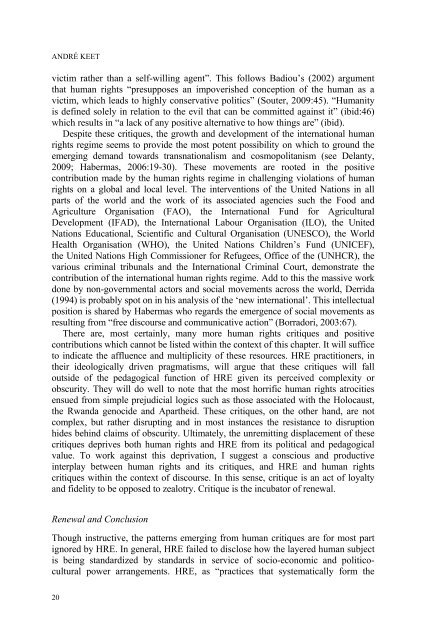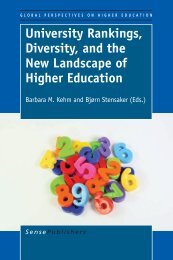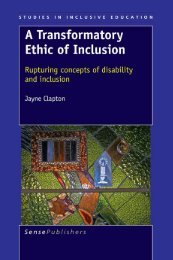Safe Spaces Human Rights Education in Diverse Contexts
Safe Spaces Human Rights Education in Diverse Contexts
Safe Spaces Human Rights Education in Diverse Contexts
You also want an ePaper? Increase the reach of your titles
YUMPU automatically turns print PDFs into web optimized ePapers that Google loves.
ANDRÉ KEET<br />
victim rather than a self-will<strong>in</strong>g agent”. This follows Badiou’s (2002) argument<br />
that human rights “presupposes an impoverished conception of the human as a<br />
victim, which leads to highly conservative politics” (Souter, 2009:45). “<strong>Human</strong>ity<br />
is def<strong>in</strong>ed solely <strong>in</strong> relation to the evil that can be committed aga<strong>in</strong>st it” (ibid:46)<br />
which results <strong>in</strong> “a lack of any positive alternative to how th<strong>in</strong>gs are” (ibid).<br />
Despite these critiques, the growth and development of the <strong>in</strong>ternational human<br />
rights regime seems to provide the most potent possibility on which to ground the<br />
emerg<strong>in</strong>g demand towards transnationalism and cosmopolitanism (see Delanty,<br />
2009; Habermas, 2006:19-30). These movements are rooted <strong>in</strong> the positive<br />
contribution made by the human rights regime <strong>in</strong> challeng<strong>in</strong>g violations of human<br />
rights on a global and local level. The <strong>in</strong>terventions of the United Nations <strong>in</strong> all<br />
parts of the world and the work of its associated agencies such the Food and<br />
Agriculture Organisation (FAO), the International Fund for Agricultural<br />
Development (IFAD), the International Labour Organisation (ILO), the United<br />
Nations <strong>Education</strong>al, Scientific and Cultural Organisation (UNESCO), the World<br />
Health Organisation (WHO), the United Nations Children’s Fund (UNICEF),<br />
the United Nations High Commissioner for Refugees, Office of the (UNHCR), the<br />
various crim<strong>in</strong>al tribunals and the International Crim<strong>in</strong>al Court, demonstrate the<br />
contribution of the <strong>in</strong>ternational human rights regime. Add to this the massive work<br />
done by non-governmental actors and social movements across the world, Derrida<br />
(1994) is probably spot on <strong>in</strong> his analysis of the ‘new <strong>in</strong>ternational’. This <strong>in</strong>tellectual<br />
position is shared by Habermas who regards the emergence of social movements as<br />
result<strong>in</strong>g from “free discourse and communicative action” (Borradori, 2003:67).<br />
There are, most certa<strong>in</strong>ly, many more human rights critiques and positive<br />
contributions which cannot be listed with<strong>in</strong> the context of this chapter. It will suffice<br />
to <strong>in</strong>dicate the affluence and multiplicity of these resources. HRE practitioners, <strong>in</strong><br />
their ideologically driven pragmatisms, will argue that these critiques will fall<br />
outside of the pedagogical function of HRE given its perceived complexity or<br />
obscurity. They will do well to note that the most horrific human rights atrocities<br />
ensued from simple prejudicial logics such as those associated with the Holocaust,<br />
the Rwanda genocide and Apartheid. These critiques, on the other hand, are not<br />
complex, but rather disrupt<strong>in</strong>g and <strong>in</strong> most <strong>in</strong>stances the resistance to disruption<br />
hides beh<strong>in</strong>d claims of obscurity. Ultimately, the unremitt<strong>in</strong>g displacement of these<br />
critiques deprives both human rights and HRE from its political and pedagogical<br />
value. To work aga<strong>in</strong>st this deprivation, I suggest a conscious and productive<br />
<strong>in</strong>terplay between human rights and its critiques, and HRE and human rights<br />
critiques with<strong>in</strong> the context of discourse. In this sense, critique is an act of loyalty<br />
and fidelity to be opposed to zealotry. Critique is the <strong>in</strong>cubator of renewal.<br />
Renewal and Conclusion<br />
Though <strong>in</strong>structive, the patterns emerg<strong>in</strong>g from human critiques are for most part<br />
ignored by HRE. In general, HRE failed to disclose how the layered human subject<br />
is be<strong>in</strong>g standardized by standards <strong>in</strong> service of socio-economic and politicocultural<br />
power arrangements. HRE, as “practices that systematically form the<br />
20














